If you use the Divvy bike-share system, it’s probably happened to you: You walk over to the nearest Divvy station only to find it empty, with no bikes available to rent. Or perhaps there’s one bike and it’s broken. Or maybe there are only electric bikes, which involve per-minute charges: 16 cents a minute for regular annual members, and a whopping 39 cents a minute for non-members.
Lack of Divvy bike availability has been reported on in the Tribune and has been the topic of much social media venting.
But how bad is the problem, exactly?
Streetsblog recently ran an analysis of Divvy data from August 2 to September 18. Over that roughly six-week period, at any given point about one in five stations has no "classic" bikes (the original blue non-electric cycles) for rent and one fifth of docked bikes were flagged as broken. (This analysis only looked at the traditional full-service stations that can park classic bikes and e-bikes, but not "E-stations" – glorified bike rack installations where only electric bikes can be secured with their built-in locks – or e-bikes parked on other bike racks or poles.)
Some popular stations were empty more than half the time. And additional data obtained from the Chicago Department of Transportation showed that Lyft, the Divvy concessionaire, consistently failed to meet its contractual service level targets. The system is owned by the city but operated under contract by the ride-hail company, who bought the previous operator Motivate. The latest extension of the contract runs through 2028.
How many stations have bikes?
We found that, most of the time, about 20 percent of all stations had zero classic bikes for rent, while about 40 percent of stations had zero e-bikes (the newer black or gray cycles.) At peak times when more bikes were in use, which occurred at about 6 p.m. most days, up to 25 percent of stations had no classic bikes available.
But a station having only a single bike isn’t great either. You might want to ride with someone, or that single bike might have a mechanical issue that hasn’t been reported yet. About half of stations had two or fewer classic bikes available.
Here’s a graph showing the percentage of stations that had a given number of classic bikes over the course of the study period.
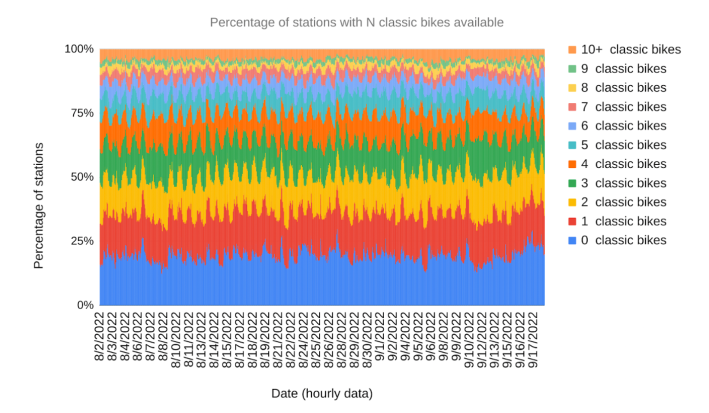
CDOT responded to a summary of the above data with this statement: “It’s a concern any time residents are struggling to find available bikes and CDOT is working closely with our partners at Lyft on strategies to improve bike availability. Ridership remains high and new bikes and stations are continuing to be added to the system to expand bike-share to all neighborhoods.” The department has previously said that bike availability has been impacted by supply chain issues and labor shortages.
Single station analysis
Looking at the system as a whole shows the big picture, but any given Divvy user is only approaching a single station at a time, often the one closest to their home or workplace. So we took an in-depth look at the station at Clark and Randolph streets in the Loop, in front of the Thompson Center and across the street from City Hall.
Over the course of the study period, this station had more than a 50 percent chance of having no classic bikes, and about a two-thirds chance of having only a single blue bike, or no classic cycles at all. So while the average station in the system would have up to a one in four chance of having no classic bikes, the likelihood of that happening Clark & Randolph was over twice that.
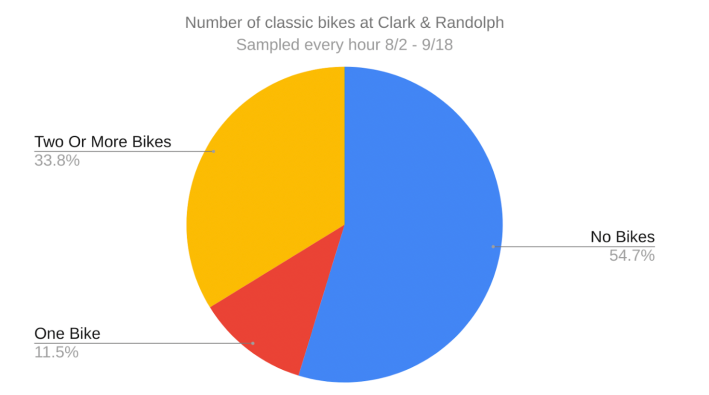
We also broke down classic bike availability at this station by time of day, for a typical week (Monday through Sunday) in August. We found that Clark & Randolph station was full during the weekday, and empty or almost empty for most evening, nighttime, and weekend hours. In the following graph, the red bars indicate a typical Monday through Friday 9 a.m. to 5 p.m. work day. We capped the blue bars at 10 bikes for easier visualization.
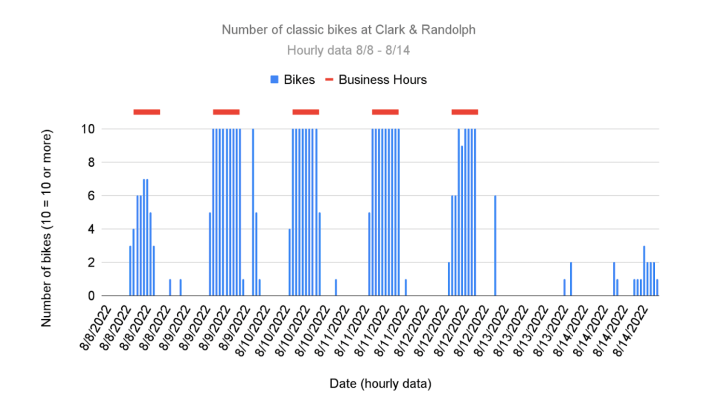
If you arrive at Clark & Randolph at noon on a weekday you are essentially guaranteed a classic bike. But after 6 p.m. on a weekday, or at any time on a Saturday, the station extremely unlikely to have any blue bikes for rent. This regular lack of availability significantly reduces the usefulness of the Divvy system.
How many bikes are available for rent?
We also looked at the total number of bikes available for rent across the whole system. Again, we only looked at bikes parked at traditional full-service docking stations.
At any given time there were about 3,000 to 4,000 bikes parked at these stations. About 50 percent of these were classic bikes that were available for rent, about 30 percent were e-bikes that are available for rent, and about 20 percent were disabled – either bikes flagged as having a mechanical issue or e-bikes that were out of battery, though these numbers varied significantly over the study period.
Here’s a graph showing which bikes were in traditional docking stations over time.
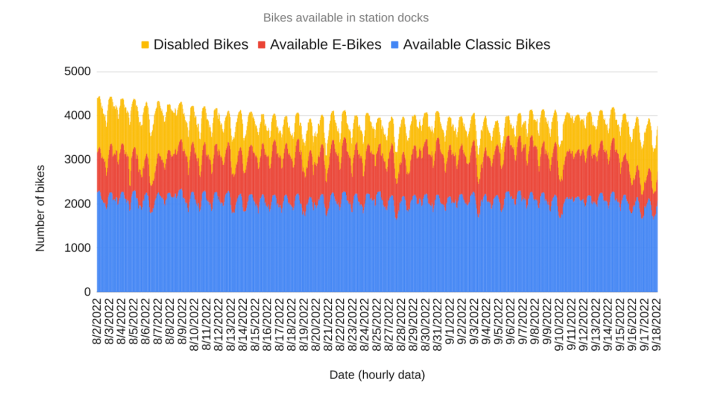
The Divvy contract defines the fleet as total purchased bikes, minus all bikes that are missing, temporarily out of service due to maintenance issues, or permanently retired. CDOT and Lyft both declined to answer questions about how many bikes are supposed to be in circulation and how many actually are.
Is Lyft hitting its contractual targets?
Lyft’s current contract states that 95 percent of stations should have “sufficient bikes,” which they define as enough cycles to occupy 10 percent of the docks at the station, from 6 a.m. through midnight. Therefore if a station has 20 docks, two bikes is deemed sufficient. But the definition has an additional complication: Any bike parked within 400 meters (about two city blocks) of the station counts.
So if there are two 20-dock stations about 1.5 blocks apart, and one of those stations has three bikes, the other has zero, and there is one e-bike locked to a regular bike rack or pole nearby, then both stations count as having “sufficient bikes,” even the empty one.
According to data obtained from CDOT via a Freedom of Information Act request, Lyft failed to meet this service level target for four of the last 12 months.
Another service target set in the contract is that at least 85 percent of the bike fleet should be deployed during the months of April through November. The data obtained from CDOT also shows that only 59 percent of the bike fleet was on the street in June, much lower than the 85 percent target, and the lowest level since this service target was defined as part of the 2019 contract extension. Lyft failed to meet its target seven out of the last eight non-winter months.
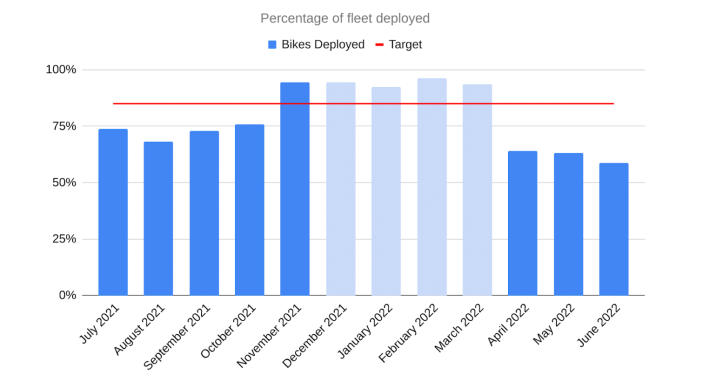
In 2021, Lyft paid a total of $67,000 in fines for missing various service level targets, although CDOT did not break down how much of the penalty came from each service target. This is less than 1 percent of the $7,500,000 minimum payment Lyft pays the city every year for the right to operate the Divvy system.
Lyft spokesperson Colin Wright, declined to estimate when Lyft will be able to meet their contractual service targets relating to bike availability, saying only, "Our goal is to provide bikes and parking where our riders need them most, and while that’s a challenge during busy months like this summer, our team is focused on steps to increase bike and parking availability. By the end of this year, we will have brought thousands of new Divvy bikes and stations to all corners of the city."
Lyft says they are working closely with CDOT on a strategy to address bike availability, although they did not specify what that strategy is, and cited theft and supply delays for parts as reasons why so many bikes are out of commission.
Section 3.9(b) of the contract requires Lyft to maintain “an adequate staff of competent personnel” for the duration of the agreement, and Section 9.1(b)(i) says that Lyft is in default of the agreement if they fail “to perform the services with sufficient personnel and equipment or sufficient material to ensure the timely performance of services.”
Since Lyft is routinely missing its performance targets, it does not appear to be retaining adequate staff and/or sufficient material to meet its commitments.
Hopefully things will get better
Anecdotally, bike availability has gotten worse, and an analysis of August and September shows things aren’t so great. And this is against a backdrop of price hikes and a shift away from classic bikes to more expensive e-bikes.
Still, there were 914,000 trips in August, a new record, so perhaps some of these issues are just growing pains, as the Divvy team learns to adapt to a more heavily-used system. Lyft also says it is on track to complete the deployment of 10,500 new e-bikes required by the latest contract renewal. While not everyone wants to pay extra for an e-bike, a higher number of bikes in the system overall should help increase the availability of classic bikes.
One possible way forward on the staffing front: Lyft is working with the nonprofit bike shop Working Bikes on a new mechanic training program, which saw its first graduates in April, to try to alleviate the shortage of bike mechanics.
We’re heading into winter, a slow season for biking when Lyft is usually able to hit its performance targets. Let’s hope it has a plan going into next spring to keep bikes available at all stations next summer.





